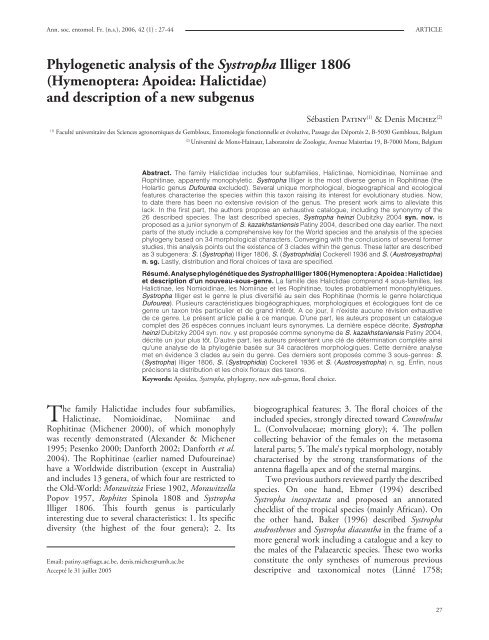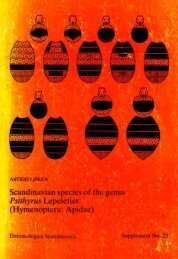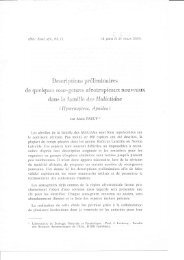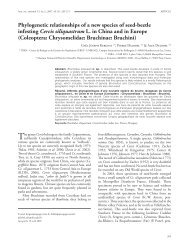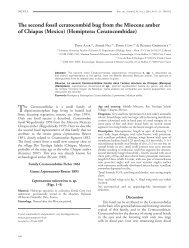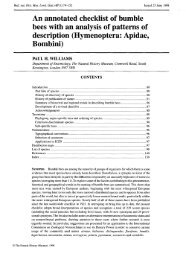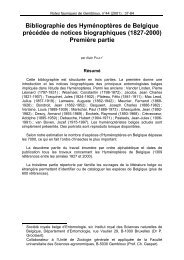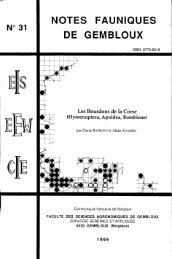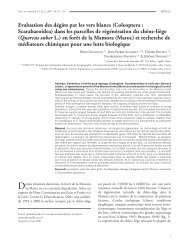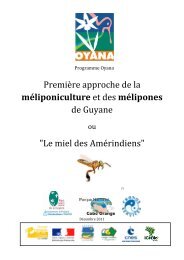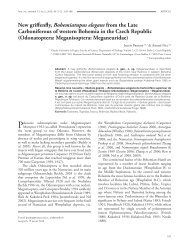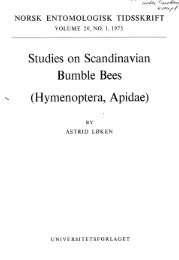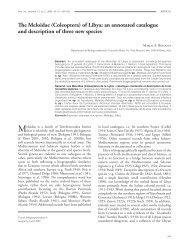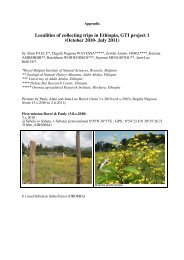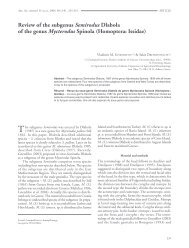Ann. soc. entomol. Fr. (n.s.), 2006, 42 (1)
Ann. soc. entomol. Fr. (n.s.), 2006, 42 (1)
Ann. soc. entomol. Fr. (n.s.), 2006, 42 (1)
Create successful ePaper yourself
Turn your PDF publications into a flip-book with our unique Google optimized e-Paper software.
S. Patiny & D. MichezFigures 5-11Sterna ♂. 5, Systropha androsthenes S2 (scale = 0.8 mm). 6, S. punjabensis S2 (scale = 0.6 mm). 7, S. diacantha S2 (scale = 1 mm). 8, S. difformis S2(scale = 1.2 mm). 9, S. curvicornis S2-3 (scale = 0.6 mm). 10, S. planidens S2-3 (scale = 1.2 mm). 11, S. aethiopica (scale = 1 mm).18. First terga margins angulous (like in S. difformisand S. inexspectata). S2 with long spiny and welldistinct tubercles. S3 with lateral angulosities.S8 apex subrectangular, transverse, rounded.Pakistan ..................................... S. popovi Ponomareva– Terga margins not angulous. S2 tubercles usuallyflattened. Tubercles on S3 more rounded. S8 different,narrower or subelliptic ................................................ 1919. Flagellum dark. A7 three times as long as wide;A8 5-6 times as long as wide. S1 medially shortemarginated. S2-3 bearing low tubercles, conformedlike in S. planidens. S8 terminal plate subelliptic,nearly as long as wide. Iran . ................ S. iranica Popov– Flagellum lower side reddish-yellow. A7-8 shorter.S2-3 with tubercles like in S. planidens but distinctlysmaller. S8 terminal plate quadratic, nearly as longas wide. Iran ........................................ S. villosa Ebmer20. Tubercles mainly developed on S2 .............................. 21– Tubercles mainly developed on S3 or S4 ..................... 2321. S2 with large angular tubercles (fig. 10). S3 withsmaller but well developed tubercles. S8 with a verylarge, well developed and differentiated terminal plate.Southern West-Palaearctic ............ S. planidens GiraudS8 apex sub-quadratic. Turkey and surrounding areas : S. planidensanatolica WarnckeS8 apex asymmetric, subelliptic, the anterior part enlarged. IberianPeninsula : S. planidens grandimargo PérezS8 apex subelliptic. Europe : S. planidens planidens Giraud– S2-3 with generally smaller processes, even if likelyshaped. S8 apex always subrectangular; distallynotched by one species. Central-Asia .......................... 2222. S3 nearly flat, with smooth areas, slightlyconvex. S8 apex not notched apico-medially.Turkmenia ................................ S. ruficornis Morawitz– S3 with well developed processes (like in S. planidens).S8 apex apico-medially notched. Kazakhstan............................................ S. kazakhstaniensis Patiny23. Tubercles mainly developed on S4. S8 apexsubrectangular, angulous. Tadjikistan ....................................................................................S. tadjika Warncke32
Phylogeny of SystrophaFigures 12-14Sternum 1 ♂. 12, Systropha hirsuta (scale = 1 mm). Sternum 8 apex ♂. 13,Systropha diacantha (scale = 0.5 mm). 14, S. maroccana (scale = 0.5 mm).– Rounded tubercles mainly developed on S3. S8 apexsubelliptic acute (close to the S. maroccana, the apicaltooth lesser differentiated). Sri Lanka ....................................................................... S. tropicalis CockerellFemales1. Palaearctic and Indian species ..................................... 2– Sub-Saharan species. .................................................... 112. Indian species .............................................................. 3– West-Palaearctic species .............................................. 43. Mouthparts as long as head and mesosoma together.Second submarginal cell large, square shaped. SriLanka ......................................... S. tropicalis Cockerell– Mouthparts, shorter than head and mesosomatogether. Second submarginal cell strongly reduced,subtrapezoidal. India ..................................................................................... S. punjabensis Batra & MichenerFigures 15-16Terga 1-3 ♂. 15, Systropha difformis (scale = 1.8 mm). 16, S. aetiopica(scale = 1 mm).4. Small species (7.5 mm). Terga margin never likelyyellowish. In the smaller taxa, the pilosity abundanton all body parts. Not endemic in these areas ............. 65. Head shorter than wide (L/W ca.1,3). Flagellum lowerside orangish. Terga margin not notably discoloured.Pilosity whitish-grey, not particularly developed onterga apex. Pp not particularly developed. Oman,United Arab Emirates ..................... S. diacantha Baker– Head rounded. Flagellum reddish on apex ventralsurface. Terga margin discoloured, yellowish.Pilosity whitish-grey. Metasoma pilosity downyon ventral surface, applied of the terga margins.Pp long with typical narrowed apex. Pakistan,Turkmenistan ............................ S. popovi Ponomareva6. Medium sized species (10 mm). Flagellum lower side paler(light reddish to yellowish) by several species. Pilositywhitish-brownish, generally sparser ............................. 77. Cuticle with blue reflect .............................................. 8– Cuticle without any blue reflect .................................. 98. Medium sized species (ca. 9 mm). Head small, thevertex few extended dorsally. Metasoma with downybrownish pilosity; on the whole body, the hairs dark,the apex generally paler. Cuticle with a light bluereflect. Palaearctic .................... S. curvicornis (Scopoli)– Large species (ca. 10 mm). Head wider, the vertexstrongly extended dorsally. Pilosity often paler,generally greyish. Cuticle with strong blue reflect.West-Palaearctic ............................ S. planidens Giraud9. Very large species (ca. 12 mm). Terga with dense apicalhairs fringes. Iranian ............................ S. villosa Ebmer– Smaller species (ca. 10 mm). Terga without hairs fringes..................................................................................... 1010. Flagellum apex reddish. Metasoma pilosity yellowishwhite,densely downy. T1-3 apical margin yellowishtransparent. Anal fringe whitish-blonde. Near-East........................................................... S. hirsuta Spinola– Flagellum black. Metasoma pilosity downy; the hairsbicolour, paler apically (globally whitish-blonde onT1-3, darker from T4). T1-3 entirely dark withoutdiscoloured margin. Anal fringe dark brownish.Morocco ................................... S. maroccana Warncke11. Tb3 inner spur smooth. Zimbabwe, Namibia ............................................................ S. glabriventris <strong>Fr</strong>iese– Tb3 inner spur with 2 strands of strong teeth alongventral edge ................................................................. 1212. Rather small species (ca. 8 mm). Pilosity white onface, mesoscutum and first terga, reddish-orangeon scutellum and metasoma apex (anal fringe andprevious sclerites). Wings hyaline. South-Africa ..................................................................... S. krigei Brauns33
S. Patiny & D. MichezFigures 17-23Systropha spp. ♂ SEM pictures. 17, head of Systropha androstenes (scale = 600 μm). 18, head of S. curvicornis (scale = 1 mm). 19, S2-3 of S. androstenes (scale= 300 μm). 20, S2 of S. curvicornis (scale = 0.5 mm). 21-22, S. planidens genitalia ventral and dorsal view (scale = 200 μm). 23, S. curvicornis genitalia dorsalview (scale = 200 μm).34
Phylogeny of SystrophaTable 1. Yielded trees’ characteristics in regard of the used analysis method and the characters weighting.Unweighted charactersCharacters weightedLength CI HI Length CI HIOrdered and unordered 79 0.5316 0.4684 31.5 0.7653 0.2347Ordered 88 0.4773 0.5227 30.34363 0.7197 0.2803Dollo.up 103 0.4078 0.5922 33.92398 0.6409 0.3591– Pilosity differently coloured ........................................ 1313. Mesoscutum and scutellum covered with rather sparseand short greyish pilosity. Metasoma with strong blackhairs on terga and sterna. Legs hairs black. Mediumsized species (ca 9 mm). Nigeria ............ S. norae Patiny– Pilosity variably dark, usually brownish on mesosoma,legs and metasoma. One of the species quite larger.Eastern-Africa ............................................................. 1414. Mesoscutum pilosity golden blonde. Terga with darkbrownish hairs; paler on sterna. Second submarginalcell subtrapezoidal. Medium sized species (ca. 9 mm).Zimbabwe .................................... S. rhodesiensis <strong>Fr</strong>iese– Mesoscutum pilosity greyish. Terga and sternawith dark brown hairs. Second submarginal cellpentagonal. Very large species (ca. 12 mm). Zanzibar................................................... S. macronasuta StrandResults of the phylogenetic analysisThe heuristic search based on the study of the dataset (appendix 2), considering the binary charactersordered, the multistates unordered and usingACCTRAN character-state optimization, yields 321equally parsimonious trees displaying a handful oftopologies (figs 24-28; tab. 1). These trees are of lengthFigure 24Selected phylogram between the most parsimonious trees (length = 79 ; CI = 0,5316 ; HI = 0,4684 ; RI = 0,7431). █ = apomorphy ; ║ = homoplasy ;▓ = reversion. Different states are indicated with « ’ ».35
S. Patiny & D. MichezFigures 25-28Selected topologies among the most parsimonious trees obtained in analysis of the data set when considering the characters unordered. Length = 79, CI =0.5316, HI = 0.4684, RI = 0.7431, RC = 0.3950.36
Phylogeny of SystrophaFigure 29Strict consensus of the most parsimonious trees (multistate charactersunordered and of equal weight). First clade = subgenus Austrosystropha,second clade = subgenus Systropha, third clade = subgenus Systrophidia.= 79, CI = 0.5316 and HI = 0.4684 (tab. 1). Afterapplication of the successive weighting method, 6equally parsimonious trees are found, in which CI =0.7653 and HI = 0.2347. The same analysis procedureconsidering the character ordered yields more trees(8836) of length = 88, CI = 0.4773 and HI = 0.5227.The successive weighting yields two trees with CI =0.7197 and HI = 0.2803. Eventually, the “dolloup”method leads to 8 trees of which length = 103, CI= 0.4078 and HI = 0.5922. When weighted in thismethod, the data set yields two trees, in which CI =0.6409 and HI = 0.3591.In regard of the strong similarity of the topologiesyielded following the various analysis methods tried,one chooses to present the cladograms issued from thefirst analysis method (considering the binary charactersordered, the multistates unordered, figs 24-28).Three species groups can be described based on thepresented cladograms (figs 24-28). One first includesS. aethiopica, S. arnoldi, S. bispinosa, S. norae andS. ugandensis, as<strong>soc</strong>iated within most of the yieldedtrees, independently of the used method. This first cladeis supported by a Jackknife value of 60 and describedby the apomorphic states of characters 7 and 29. Thefive species included are notably well-characterised bythe shape of the Tb3 spur. Within this first group, threespecies, S. bispinosa, S. norae and S. ugandensis, forma very stable clade also supported by high Jackknifevalue (99). The species included in this latter group arecharacterised by apomorphic states of the characters 2,15, 16, 21 and 34. These three species share notablyTable 2. Compared morphology of the subgenera.Characters Systropha s.str. Systrophidia Cock. Austrosystropha subg.nov.MalesFlagellum apexA9 and following well differentiatedin spiral arrangementA9 and following fused in a singleshort hookA9 and following all long, welldifferentiated, in spiral arrangementLegs parts differentiationF2 dorso-ventrally enlarged by somespeciesDevelopment of teeth on Terga Terga untoothed, except T6 by S.maroccana, T7 by S. difformisTr2, F2, Tr3 and F3 carinated. Cx3with a typical inner budT7 laterally toothedSterna tubercles differentiation Well developed tubercles on S2-4 Tubercles strongly reduced, first sternawith small smooth areasF1 usually enlarged dorso ventrallyand laterally. F2 often enlarged as wellas Tb2 proximal part. Cx3 distallyenlarged by several speciesT7 always laterally toothed. T6bearing often teeth. T1-5 with angularor spiny graduli by S. aethiopica andS. arnoldiSterna margin variably transformedin wide expansions (S. aethiopica, S.arnoldi) or in low blade-like marginsS8 apical enlargement S8 apex variably enlarged S8 apex elliptically enlarged S8 apex elliptically enlarged or notenlarged but with a well developedventral grooveFemalesTb3 inner spur Straight and finely toothed - Curved and coarsely toothedfollowing 2 ventral ranksSterna pilosity Less developed, downy - Densely developed, lesser downy,coarse by several species.37
S. Patiny & D. MichezTable 3. Literature reported data on the species floral choices. Except when otherwise precised, the quoted botanic genera belong to Convolvulaceae.Systropha species Visited plant species ReferencesSubgenus SystrophaS. androsthenes Baker Convolvulus sp. Low-growing species Baker (1996)S. curvicornis Scopoli Asteraceae : Cichorium intybus L. used as shelter; Convolvulaceae : CalystegiaR.Brown, Convolvulus sp.; Convolvulus arvensis L.; Fabaceae : Melilotus albusMedikus ; Linaceae : Linum hirsutum L.S. inexspectata Ebmer Convolvulaceae : Convolvulus sp. ; species with white flowers, interpreting Baker’sreading of the Cockerell’s labellingS. iranica Popov Convolvulaceae : Convolvulus leiocalycinus Boissier, Convolvulus spinosus Burman;Punicaceae : Punica granatum L.<strong>Fr</strong>iese (1901); Stoeckhert (1933);Herbert (1982); Baker (1996)Baker (1996); Ebmer (1994)Popov (1967); Baker (1996);Warncke (1980)S. maroccana Warncke Convolvulaceae : Convolvulus trabutianus Schweinfurth & Muschler Baker (1996)S. pici Pérez Convolvulaceae : Convolvulus spinosus Burman Baker (1996)S. popovi Ponomareva Convolvulaceae : Convolvulus sp. Ponomareva (1967)S. planidens Giraud Convolvulaceae : Convolvulus arvensis L. <strong>Fr</strong>iese (1901); Ebmer (1978);Herbert (1982); Stoeckhert (1933)S. punjabensis B.&M. Convolvulaceae : Convolvulus arvensis L. Batra & Michener (1966)S. tropicalis Cockerell Convolvulaceae : Convolvulus sp. <strong>Fr</strong>iese (1913)(butteli <strong>Fr</strong>iese)Subgenus SystrophidiaS. glabriventris <strong>Fr</strong>iese Convolvulaceae : Merremia palmata Hallier f. original data (AMNH)Subgenus AustrosystrophaS. ugandensis Cockerell Convolvulaceae : Convolvulus sp. Cockerell (1931)the synapomorphic development of tubercles on themesopleura ventral surface. Within the yielded trees,S. glabriventris constitutes a single species clade, whichis as<strong>soc</strong>iated with the previous described species-set (figs25, 27) or placed as the Systropha sister-species (figs 26,28). The other species included in the analysis forma third notable clade including the species displayingstrongly differentiated processes on the S1-6. However,the terminal groupings of the included species arerather variable and the clade is only supported bylow Jackknife score (39). This latter group contains:S. androsthenes, S. punjabensis, S. kazakhastaniensis,S. diacantha, S. maroccana, S. curvicornis, S. hirsuta,S. pici, S. popovi and S. planidens, most of thesepreviously included in the Ponomareva’ species groups.These latter species are interestingly characterised by theuntoothed tibial spur (character 19). Within this cladeS. androsthenes and S. punjabensis, displaying a strongreduction of the last falgellum segments, constitute anotable group supported by a Jackknife of 48.Subgenera descriptions and diagnosesSystropha Illiger 1806 s.str.Type species. S. curvicornis (Scopoli 1770); by monotypyPrevious descriptions. Ponomareva (1967), Batra & Michener (1986)and Baker (1996)Diagnosis (see also tab. 2; figs 1, 5-10, 12-13, 15, 17-23). Mediumsized species. Mouthparts of usual length (see figures in Ebmer1994). ♀. Tb3 inner spur straight, finely toothed. Metasomalpilosity dense and downy. Flagellum short but not particularlythick. ♂. Antennae with 13 well-developed segments; in somespecies less than 13 segments (S. androsthenes, S. punjabensis).These latter segments distinct, not fused in a single terminalhook. F1, Tb2, Cx3 weakly differentiated, not enlarged. Terga nottoothed laterally (except T6 by S. aroccana; T7 by S. difformis).First sterna (S1 in one species; S2-S3 in most taxa) with welldeveloppedtypical processes. S8 apex strongly differentiated,variably shaped and bearing typical terminal appendages (by S.diacantha, S. difformis, S. maroccana, S. tropicalis).Included species. S. androsthenes, S. curvicornis, S. diacantha, S.difformis, S. hirsuta, S. inexspectata, S. iranica, S. kazakhstaniensis,S. maroccana, S. pici, S. planidens, S. popovi, S. punjabensis,S.ruficornis, S. tadjika, S. tropicalis, S. villosa.Floral choices. Tab. 3Distribution. Palaearctic, see details in the keySystropha (Systrophidia) Cockerell 1936Type species. S. glabriventris <strong>Fr</strong>iese 1922; by monotypyPrevious descriptions. Cockerell (1936) and Batra & Michener (1986)Diagnosis (see also tab. 2; figs 2, 4). Very large species.Mouthparts strongly elongated (as long as half of the bodylength). PMx unusually short. ♀. Tb3 inner spur smooth.Metasoma with short and not notably downy pilosity. Flagellumshort and thick. ♂. Antennae with 8 normal segments; theflagellum apex forming a short hook. F1, Tb2, Cx3 weaklydifferentiated. F2 longitudinally carinate. T6-7 laterallytoothed. First sterna without process. S8 apex almond-shaped.Included species. S. glabriventrisFloral choices. Tab. 3Distribution. Namibia, Zimbabwe38
Phylogeny of SystrophaSystropha (Austrosystropha) n. subg.Type species. S. norae Patiny 2004Etymology. The group includes exclusively Sub-Saharan speciesdistributed south of the Tropic of Cancer. The subgenus namerefers to this characteristic Southern distribution.Diagnosis (see also tab. 2; figs 11, 16). ♀. Tb3 inner spurthick, sigmoid, with two rows of coarse teeth along the ventraledge. Metasomal pilosity rather sparse and less downy than inSystropha s.str; more abundant on sterna. ♂. Antennae always13-segmented; the last five segments of usual length, spiral,usually a little flattened. F1 inflated. Tb2 dorso-ventrallyenlarged in several species. Cx3 enlarged, apex angulate (in agroup of 3 species). At least the T7 laterally toothed. First sternawith low processes. S8 apex elliptical subperpendicular to thesternum base or not enlarged and displaying a typical ventrallongitudinal groove.♀. Head. Facial pilosity usually pale, well-developed.Mouthparts shorter than head and mesosoma together. Ocellararea convex. Mesosoma. Mesoscutum and scutellum withshort continuous blonde or grey pilosity. Tb3 inner spur thicksigmoid with two ventral ranks of coarse teeth. Metasoma.Terga and sterna with usually strong hairs (less downy than bySystropha s.str.); pilosity abundant on sterna.♂. Head. Facial pilosity forming long crests of hairs behindscape. Genae densely hairy; the ventral part with a beard-likepilosity. Ocellar area convex. A3 long. Flagellum last segmentsspiral, usually sensitively flattened; antennae 13-segmented.Mesosoma. Propodeal area depressed. Several species with theventral portion of the mesopleura arched or bearing distincttubercles. F1 inflated. Proximal part of Tb2 enlarged. Cx3angular; apex enlarged. Metasoma. Terga graduli angularor forming a spine in some species. T7 laterally toothed inall species. First sterna processes appearing as a low bladelikemodification of the S2(3) margin. These latter structuressometimes very large. Terminal appendages of S7 large. Apex ofS8 almond-shaped or narrower with a typical ventral groove.Included species. S. aethiopica, S. arnoldi, S. bispinosa, S. krigei,S. macronasuta, S. norae, S. rhodesiensis, S. ugandensisFloral choices. Tab. 3Distribution. Sub Saharan Africa, see details in the keyDiscussionSpecies taxonomyPrior to the previous catalogue, the status of severalspecies remained unclear in the available literature(Ebmer 1994; Baker 1996). The solutions proposed tothese taxonomical problems in the present work arediscussed hereafter.Ebmer (1979, following the label’s date) designatedone female conserved in the NHM (London)collections as the S. aethiopica <strong>Fr</strong>iese allotype. Now,when comparing this latter specimen with the speciesholotype (ZMHB, Berlin), the Ebmer’s designationseems not relevant in regard of the available evidences.The male holotype is unusually much bigger than theproposed allotype. Moreover, the two specimens differstrongly by the abundance and colour of the pilosity,whereas these features are generally very similar inmales and females in the other species of the genus.One can even doubt that the designated femalebelongs to the subgenus S. (Austrosystropha) in whichS. aethiopica is placed based on several strong malecharacters (observed on the holotype; see catalogueand cladistic analysis). None of the S. (Austrosystropha)diagnostic character, notably the typical coarselytoothed Tb3 inner spur by females, is displayed by theproposed allotype. <strong>Fr</strong>om the biogeographical point ofview, no more argument can be found supporting thetwo specimens as<strong>soc</strong>iation. The holotype locus typicus“Br. O. Afrika, Mulango”, following the specimen’slabelling, can in no way be evidently related to this ofthe proposed allotype “Dhofar, Wadi Sayq s.l.”. Theseobservations lead to conclude that no character supportsthe as<strong>soc</strong>iation of the male holotype and the femaleallotype. Consequently, S. aethiopica is considered here(see the key and the matrix in appendix) as known bythe males only. Currently, one chooses to not describethe Ebmer’s female, having only one specimens withoutany strong morphological features.A second taxonomical problem consists in the statusgiven to the taxa implied in the S. hirsuta complex:S. christae, S. hirsuta, S. pici, which includes in factonly two well-distinct species. On one hand, S. pici isa small species seemingly close to S. planidens. On theother hand, S. hirsuta is a typical taxon, of which malesare uniquely characterised by the differentiation of aprocess on S1 (fig. 12). Baker (1996) pointed out thatPonomareva (1967) and Warncke (1977) introducedmore and more confusion between S. hirsuta andS. pici, due to misidentifications of S. pici erroneouslynamed S. hirsuta. One notes that this confusion wasearlier already made by <strong>Fr</strong>iese. The Berlin museumseries contain notably one specimen caught in Algeriain 1890, obviously belonging to S. pici and labelled“Systropha hirsuta Spin. det. <strong>Fr</strong>iese 1898”. The thirdspecies included in the complex, S. christae, must beconsidered as a junior synonym of S. hirsuta. In theabove catalogue, after the types revision, we followedthe Baker’s synonymy, considering S. pici and S. hirsutaas distinct species. S. pici is North-African, describedon the basis of female from Ain Sefra (Algeria) andalso present in Morocco. S. hirsuta is a species fromNear-East. The male lectotype is from Egypt (Casolari& Casolari 1978; Baker 1996) and several specimenswere caught in Israel (S. christae; Warncke 1972).The NHM (London) series contain also twospecimens from Uganda, labelled S. antinorii andbelonging to S. bispinosa <strong>Fr</strong>iese. We cannot find anytrace in literature and other collections of the name39
S. Patiny & D. Michezantinorii. This latter was consequently not quotedin the previous catalogue. However, the concernedspecimens have a high biogeographical interestbecause they constitute a first record of the species inEastern Africa and a strong eastward expansion of theS. bispinosa distribution.The present catalogue includes naturally also themore recently described species: S. kazakhstaniensisPatiny 2004 and S. norae Patiny 2004. The lastdescribed species, S. heinzi Dubitzky 2004 (descriptionpublished on the 1 st of December) is proposed as a newsynonym of S. kazakhstaniensis (description publishedon the 30 th of November).Supraspecific levelAt higher taxonomical level, several subgenera andspecies groups were formerly described in Systropha(Cockerell 1936; Ponomareva 1967; Batra & Michener1966). Nowadays, no study of the concerned speciesphylogenetic relationships supports these groupingsand taxonomical propositions. The trees presentedin the frame of the present study (figs 24-29) areconsequently the first evidences supporting the genussubdivision into subgenera. Three species groups aredescribed as subgenera based on the results of thephylogeny analysis: Systropha s.str., Austrosystrophan. subg. and Systrophidia (tab. 2). The first includesthe species contained in the two Ponomareva’ speciesgroups, the second consists in most sub-Saharan species(not considered by the previous authors) and the lastkeeps its original definition as given by Cockerell(1936), containing S. glabriventris only.Among the three described subgenera, Systrophas.str. appears less consistent and more variable (onlysupported by low jackknife values). However, theobserved variability consists mainly in the includedspecies terminal groupings and not in the subgenusspecific composition. Light changes in this latter areonly observed when one considers the charactersordered or “dollo.up”. Following these latter methods,Systropha s.str. include only S. curvicornis, S. hirsuta,S. kazakhstaniensis, S. pici, S. planidens and S. popovi,while S. androsthenes-S. punjabensis and S. difformis-S. tropicalis are excluded and form most often distinctgroups.On the contrary, Austrosystropha n. subg. isstrongly supported in the computed topologies,scoring high jackknife values. <strong>Fr</strong>om the morphologicalpoint of view, the subgenus can be described based onnumerous characters, included or not in the analyzeddataset (tab. 2, subgenera descriptions). One of themore typical characters supporting the Austrosystrophamonophyly is the coarse teeth of the female innerhind tibial spur. Systropha females display in mostspecies a straight and nearly smooth hind spur. On thecontrary, the known females of African species havea typical strong, sigmoid and coarsely toothed spur.This character was not included in the studied datasetbecause in African species one usually lacks one of thetwo sexes. The inclusion of these characters wouldconsequently lead to the introduction of numerousindeterminations cases. However, observations madeon S. norae females and not previously studied samplesof S. bispinosa (MRAC), confirm the interest of thischaracter. In the studied data set, one inserts a characterrelative to the male spur morphology (character 19),also sensitively different in Austrosystropha. In males,the development of facial hairs crests (character 01) isanother typical character for Austrosystropha. One notesthat this character is also observed in S. tropicalis, whichis grouped with the Austrosystropha when consideringcharacters of the type dollo.up. The species included inAustrosystropha share several other characters, notablythe previously discussed shape of the females Tb3 innerspur but also F1 differentiation, the Cx3 enlargementand the development of teeth on T7 (characters 16, 19,24). Within Austrosystropha, another species group canbe identified. This latter pools the taxa characterisedby the development of tubercles on the mesopleuralventral surface (character 21). S. bispinosa, S. noraeand S. ugandensis display such structures variablywell individualised following species, while the otherAustrosystropha have usual flat mesopleura. Despite thisdichotomy, the Austrosystropha are considered, basedon the previous topologies (figs 24-29) as forming asingle group.As stated in the results chapter, S. glabriventris isgenerally excluded of the previous species groups andseems to constitute a monobasic subgenus as earliersuggested by Cockerell (1936). This latter speciesis morphologically very well-distinct of the otherSystropha and can be easily considered as the sisterspeciesof the Austrosystropha or of all the other species(figs 24-29). This appears particularly interestingin regard of the species distribution. In varied beesgroups (like Meganomiinae, Rediviva, Mermiglossinai.e.; Michener 1981; Patiny 2001; Ascher 2004), onefind sister-group of other more diversified taxa isolatedin Southern Africa (notably in Namibia). ConsideringS. glabriventris as the Systropha or Austrosystrophaoutgroup leads to the description of an similarbiogeographical pattern.Moreover, from the biogeographical point of view,the three described subgenera are well separated oneof each other. Systropha s.str. are strictly Palaearctic,the most southern encountered species being40
Phylogeny of SystrophaS. tropicalis (Sri Lanka) and S. maroccana (Morocco).S. (Austrosystropha) are strictly subsaharan, rangingmainly in southern and eastern Africa. Northern,they seem distributed in the northern savannas ofCentral Africa, reaching Cameroon and Nigeria tothe west. Eventually, the early described subgenusS. (Systrophidia) is restricted, according to the currentknowledge, to Namibia and Zimbabwe. The presenceof this species in Botswana too cannot be excluded.Floral choicesWe did not use aspects of the species ecology asdescriptors in the previous phylogenetic analysis.However, it is important to point out that the Systrophadisplay a remarkable level of oligolecty (monolectyin some species). As it’s shown by the floral recordsreported for 11 of the 26 described species (tab. 3). Inmost cases, specimens were caught on Convolvulaceae,mainly on Convolvulus L. Based on these data, onecan hypothesize a strong (nearly exclusive) as<strong>soc</strong>iationof Systropha with Convolvulus. Only two species,S. curvicornis and S. iranica, were caught while visitingother host plants. In the case of S. curvicornis, it canreasonably be suggested that the large distribution ofthe species lead to more opportunities for unusualadaptative behaviours. Moreover, it seems that theseexceptions to the general oligolecty of the species areanecdotic.Among the Convolvulus species visited by theSystropha, several vegetative forms are represented.C. spinosus and C. trabutianus are bush species,typically growing in steppes. On the contrary,C. arvensis, visited by several species (tab. 3), is a lowgrowing herbaceous plant. One can wonder if thestudied bees are linked to the flower type or to thevegetative form. However, despite these morphologicaldivergences in the host plants, the available datasuggest an as<strong>soc</strong>iation between Systropha and species ofConvolvulus with tricolporate pollen grains (Wodehouse1965). The record on Calystegia sp. is the only one on aConvolvulaceae with another pollen morphology.In Systropha, one notes the absence of variation inthe floral choices of the three subgenera. Contrary toother groups of bees (Dasypoda Latreille 1802 e.g.), inwhich it seems exist an evolutionary relation betweenthe choice of the food resources and the subgenericdivergence (Michez et al. 2004), it seems that theecological preferences were here conserved during anddespite the evolutionary radiation.ConclusionsThe present work fixes several taxonomical problemspreviously still remaining in the Systropha classification.One also gives the first exhaustive catalogue for theWorld species, including the most recently describedones.In the supraspecific level, three subgenera aredescribed or re-described. The previous position ifspecies included in Systropha s.str. and S. (Systrophidia)is not modified. All the subsaharan species forwhich no precise subgeneric classification had beenpreviously suggested, fall into the new subgenus S.(Austrosystropha). Parallel to this action in the grouptaxonomy, a first analysis of the species phylogeneticrelationships is realised.No particular study was directed to enhancethe knowledge of the Systropha floral choices.However, having a particularly wide overview of theavailable literature, one sets the first synthesis of thatknowledge. This part of the work underlines clearly theoligolecty of the genus species on the Convolvulus andConvoluvulaceae Convolvulus-like flowers.Acknowledgements. The author wants to thank sincerely Prof.B.N.Danforth (Cornell, Ithaca) for reviewing the last draftof the text, as well as Prof. C.D.Michener (KU, Lawrence),Dr. J.Ascher (AMNH, New-York), Mr. G.Else (BMNH,London), Mag. F.Gusenleitner (OÖL, Linz), P. A.W.Ebmer(Puchenau) and Mr. A.Pauly (FuSaGx, Gembloux) for theirkind collaboration in specimens revision.During first year of this research preparation D. Michez wasgranted by FRIA (Fonds pour la Formation à la Recherche dansl’Industrie et dans l’Agriculture). S. Patiny is a FNRS (Fondsnational de la Recherche scientifique) scientific collaborator.ReferencesAlexander B.A. , Michener C.D. 1995. Phylogenetic studies of the familiesof short-tongued bees (Hymenoptera : Apoidea). The University ofKansas Science Bulletin 55: 377-<strong>42</strong>4.Allard M.W. , Carpenter J.M. 1996. On weighting and congruence.Cladistics 12: 183-198.Ascher J.S. 2004. Systematics of the bee family Andrenidae (Hymenoptera:Apoidea). Ph-D, Cornell Univeristy, Ithaca, 332 p.Baker D.B. 1996. Notes on some palaearctic and oriental Systropha, withdescriptions of new species and a key to the species (Hymenoptera:Apoidea: Halictidae). Journal of Natural History 30: 1527-1547.Batra S.W.T. , Michener C.D. 1966. The nest and description of a newbee, Systropha punjabensis from India (Hymenoptera: Halictidae).Journal of the Kansas Entomological Society 39: 650-658.Brauns H. 1926. V. Nachtrag zu „<strong>Fr</strong>iese, Bienen Afrikas“. ZoologischeJahrbücher. Abteilung für Systematik, Geographie und Biologie der Tiere52: 187-230.Carpenter J.M. 1994. Successive weighting, reliability and evidence.Cladistics 10: 215-220.Casolari C. , Casaroli R. 1978. Catalogo della collezione imenotterologicadi Massimiliano Spinola, 1a Parte. Bollettino del Museo Zoologiadell‘Università di Torino 5: 27-74.Cockerell T.D.A. 1911. Descriptions and Records of Bees. XXXIV. <strong>Ann</strong>alsand Magazine of Natural History (Ser.8) 7: 225-237.Cockerell T.D.A. 1931. Some African Bees. <strong>Ann</strong>als and Magazine ofNatural History (Ser.10.) 8: 400-405.41
S. Patiny & D. MichezCockerell T.D.A. 1936. Descriptions and Records of Bees. CLIV. <strong>Ann</strong>alsand Magazine of Natural History (Ser.10) 17: 477-483.Danforth B.N. 2002. Evolution of Sociality in a primitively eu<strong>soc</strong>iallineage of Bees. Proceedings of the National Academy of Sciences of theUnited States of America 99: 286-290.Danforth B.N., Brady S.G., Sipes S.D. , Pearson A. 2004. Single-CopyNuclear Genes Recover Cretaceous-Age Divergences in Bees. SystematicBiology 53: 309-326.Dubitzky A. 2004. A new bee from central Asia: Systropha heinzi sp.n.Mitteilungen der Munchen Entomologische Gesellschaft 94: 69-73.Ebmer A.W. 1978. Halictus, Lasioglossum, Rophites und Systropha aus demIran (Halictidae, Apoidea). Sowie neue Arten aus der Paläarktis. Linzerbiologische Beiträge 10: 1-109.Ebmer A.W. 1994. Systropha difformis Smith, 1879 und Systrophainexspectata n.sp., die beiden östlichen Vertreter der altweltlichenGattung Systropha Illiger 1806 (Insecta: Hymenoptera: Apoidea:Halictidae: Rophitinae). Linzer biologische Beiträge 26: 807-821.Eversmann E. 1852. Fauna hymenopterologica Volgo-Uralensis(Continuatio) Familia Anthophilarum seu Apidarum. Bulletin de laSociété des Naturalistes de Moscou 25: 3-137.Farris J.S. 1969. A successive approximations approach to characterweighting. Systematic Zoology 18: 374-385.<strong>Fr</strong>iese H. 1901. Die Bienen Europas (Apidae europaeae). Theil VI, solitäreApiden : Subfam. Panurginae, Melittinae, Xylocopinae. Innsbruck, C.Lampre, 284 p.<strong>Fr</strong>iese H. 1911. Nachtrag zu „Bienen Afrikas“. Zoologische JahrbücherAbteilung für Systematik, Geographie und Biologie der Tiere 30: 651-670.<strong>Fr</strong>iese H. 1913. Neue Bienenarten von Ceylon (Hym.). DeutscheEntomologische Zeitschrift 1913: 84-89.<strong>Fr</strong>iese H. 1914. in Schulthess A. XIV Fam. Apidae. Hymenopteren ausKamerun gesammelt von Herrn von Rothkirch, Oberleutnant derSchtutztruppe. Deutsche Entomologische Zeitschrift 1914 (3): 292-297.<strong>Fr</strong>iese H. 1922. III. Nachtrag zu „Bienen Afrikas“. Zoologische JahrbücherAbteilung für Systematik, Geographie und Biologie der Tiere 46: 1-<strong>42</strong>.Giraud J. 1861. <strong>Fr</strong>agments <strong>entomol</strong>ogiques. I. Description de plusieursApides nouvelles et observations sur quelques espèces connues.Verhandelungen der k.k. zoolgisch-botanischen Gesellschaft in Wien 11:447-470.Herbert F. 1982. Die Hymenopteren des Nordostalpengebietes und seinevorlandes. I Teil. Österreichische Akademie der Wissenschaften 124: 1-370.Illiger J.C. 1806. William Kirby‘s Familien der bienenartigen Insekten.Magazin für Insektenkunde 5: 28-175.Linné C. 1758. Systema Naturae per Regna tria Naturae. Tomus I. Holmiae,decima, reformata, 824 p.Michener C.D. 1981. Classification of the bee family Melittidae witha review of species of Meganomiinae. Contribution of the AmericanEntomological Institute 18: 1-135.Michener C.D. 2000. The bees of the world. Baltimore, The Johns HopkinsUniversity Press, 913 p.Michez D., Terzo M., Rasmont P. 2005. Phylogénie, biogéographie etchoix floraux des abeilles oligolectiques du genre Dasypoda Latreille1802 (Hymenoptera, Apoidea, Melittidae). <strong>Ann</strong>ales de la Société<strong>entomol</strong>ogique de <strong>Fr</strong>ance (m.s.) 40: <strong>42</strong>1-435.Morawitz F. 1880. Ein Beitrag zur Bienen-Fauna Mittel-Asiens. Bulletin del‘Académie impériale des Sciences de Saint-Pétersbourg 26: 337-389.Olivier G.A. 1789. Andren, Andrena in Anonym Encyclopédie méthodique.Histoire naturelle. Entomologie, ou Histoire naturelle des Crustacés desArchnides et des Insectes. Paris, Panckoucke, 130-140 p.Pallas P.S. 1773. Reise durch versichiedene Provinzen des Russischen Reichs.Zweiter Theil. Erstes Buch vom Jahr 1770. Kaiserlichen Akademie derWissenschaften, 1-744 p.Patiny S. 2001. Monographie des Panurginae de l‘ancien monde(Hymenoptera : Apoidea, Andrenidae). Ph-D, Faculté universitaire desSciences agronomiques de Gembloux, Gembloux, 266 p.Patiny S. 2004. Description of two new Systropha Illiger 1806(Hymenoptera, Halictidae, Rophitinae). Linzer biologische Beiträge 36:907-912.Pérez J. 1895. Excursion Entomologique dans la province d‘Oran (Algérie)(suite) Description des Hyménoptères nouveaux. Revue scientifique duBourbonnais et du Centre de la <strong>Fr</strong>ance 8: 173-180.Pérez J. 1905. Espèces nouvelles d‘Hyménoptères de Catalogne. Bulleti dela Institutcio Catalana d‘Historia Natural 5: 81-88.Pesenko Y.A. 2000. Phylogeny and classification of the family Halictidaerevised (Hymenoptera: Apoidea). Journal of the Kansas EntomologicalSociety 72: 104-123.Ponomareva A.A. 1967. Notes sur les espèces paléarctiques du genreSystropha Ill. (Hymenoptera, Apoidea, Halictidae). Polskie PismoEntomologiczne 37: 677-698.Popov V.B. 1960. Novye i maloizvectnye vidy pchelinykh (Hymenoptera,Apoidea) iz Turkmenii [New and little-known bees (Hymenoptera,Apoidea) from Turkmenia]. Trudy Zoologicheskogo Instituta AkademiiNauk SSSR 27: 247-263. (in russian)Popov V.B. 1967. Pchelinye (Hymenoptera, Apoidea) Irana [The bees(Hymenoptera, Apoidea) of Iran]. Trudy Zoologicheskogo InstitutaAkademii Nauk SSSR 43: 184-216 (in russian).Scopoli J. A., 1770. Dissertatio de Apibus. pp. 7-47. in <strong>Ann</strong>us IV Historico-Naturalis. 152pp. Lipsiae, Christ. Gottlob, Hilscher.Smith F. 1879. Description of new species of Hymenoptera in the collection ofthe British Museum. London, British Museum, 240 p.Spinola M. 1838. Des Hyménoptères recueillis par M. Fischer pendantson voyage en Egypte, et communiqués par M. Le Docteur Waltl àMaximilien Spinola. <strong>Ann</strong>ales de la Société Entomologique de <strong>Fr</strong>ance 7:437-512.Stoeckhert F.K. 1933. Die Bienen <strong>Fr</strong>ankens (Hym. Apid.). <strong>Fr</strong>iedländer &Sohn, Berlin, VIII + 294Strand E. 1911. Neue afrikanische Nomia-, Systropha- und TetraloniaArten. Entomologische Rundschau 28: 110-112.Swofford D.L. 2001. PAUP 4.0b10. Sunderland, Sinauer As<strong>soc</strong>iates, 144p.Warncke K. 1977. Beitrag zur Bienenfauna des Iran. 2. Die GattungSystropha Ill. Bollettino del Museo Civico di Storia Naturale di Venezia28: 93-97.Warncke K. 1980. Die Bienengattungen Nomia und Systropha im Iranmit Ergänzungen zu den Nomia-Arten der Westpaläarktis. Linzerbiologische Beiträge 12: 363-384.Warncke K. 1992. Die Bienengattungen Systropha Ill neu für Israel undZentralasien. Linzer biologische Beiträge 24: 741-746.Wodehouse R.P. 1965. Pollen grains. Hafner Publishing Company, New-York and London. 574 pp.<strong>42</strong>
Phylogeny of SystrophaAppendix 1.Characters used for the phylogeny relationshipsanalysis.01. Development of the males’ facial pilosity0, undifferentiated; 1, forming typical crests behindscapes02. A3 elongation0, A3 short; 1, A3 elongated03. Differentiation of the males’ antennae apex0, males’ antennae apex straight; 1, males antennaeapex spiral04. Males’ flagellum reduction0, flagellum with 13 well-differentiated segments; 1,less than 13 segments, the apical very short; 2, less than13 segments; the apical forming a typical hook05. PMx relative size0, PMx shorter than PLb; 1, PMx longer than PLb06. Mouthparts elongation0, mouthparts shorter than half of the body length; 1,mouthparts as long as, or longer than, half of the bodylength07. Ocellar area convexity0, ocellar area flat; 1, ocellar area notably convex08. Reduction of the submarginal cell number0, Forewing with 3 submarginal cells; 1, Forewing with2 submarginal cells09. Size of the first submarginal cell0, first submarginal cell short and straight; 1, firstsubmarginal cell longer and curved10. Shape of the second submarginal cell (using the Rs/Rs+M ratio as estimator)0, second submarginal nearly as wide anteriorly asposteriorly; 1, second submarginal narrowed; 2, secondsubmarginal cell unusually narrowed11. Position of the 1m-cu vein junction on Rs+M of 2sdsmarginal cell0, distal; 1, median12. Enlargement of the males’ F10, F1 dorso-ventrally enlarged; 1, F1 dorso-ventrallyand laterally enlarged, appearing inflated13. Enlargement of the males’ F20, F2 not enlarged; 1, F2 dorso-ventrally enlarged14. Males’ F2 carinate0, not carinate; 1, carinate15. Enlargement of the males’ Tb20, tibia proximal half not enlarged; 1, tibia proximalpart nearly as large as the distal part16. Enlargement of the males’ Cx3 apex0, Cx3 apex not enlarged; 1, Cx3 flattened, distallyenlarged17. Hind tarsus median segments size0, segments 3&4 of the Hind tarsus short; 1, segmentslong18. Males’ Bt3 elongation0, Bt3 less than 0,6 time as long as Tb3; 1, Bt3 longer19. Males Tb3 inner spur0, ventral edge of the Tb3 inner spur finely toothedalong 2 ranks; 1, spur seemingly smooth20. Propodeal area depression0, propodeal area not depressed, propodeum regularlyconvex; 1, propodeal area depressed21. Development of tubercles on the males’ mesopleuraeventral part0, males’ mesopleurae flat; 1, males’ mesopleurae withshort spiny tubercles; 2, males’ tubercles larger (S.norae)22. Lateral differentiation of the males’ terga graduli0, graduli undifferentiated laterally; 1, graduli forminglateral spines on first terga23. Males’ T6 laterally toothed0, T6 untoothed; 1, T6 toothed24. Males T7 laterally toothed0, T7 untoothed; 1, T7 toothed25. Differentiation of processes on the males’ S20, S2 without process; 1, S2 margin notably convex; 2,S2 margin well differentiated in process(es)26. Males’ S2 with paired processes0, S2 processes unpaired; 1, S2 processes paired27. Differentiation of processes on the males’ S30, S3 without process; 1, S3 margin notably convex; 2,S3 margin with well differentiated process28. Males’ S6 with a longitudinal carina0, carina absent; 1, carina low; 2, carina well convex;3 carina with well individualized proximal and distalteeth29. Males’ S6 with a terminal angular bud0, S6 apex undifferentiated; 1, S6 with one apicalmedian tooth; 2, S6 with 2 successive teeth along itslongitudinal axis30. Males’ S7 terminal processes tapered0, S7 terminal processes large; 1, S7 terminal processesapex tapered31. Males’ S8 apex enlarged0, S8 apex not enlarged; 1, S8 strongly enlarged andflattened32. Males’ S8 enlargement almond-shaped0, S8 apex other; S8 apex with a typical elliptic almondlike shape33. Males’ S8 apex bearing small terminal process(es)0, S8 without terminal process; 1, S8 apex toothed34. Males’ S8 apex with a ventral groove0, no differentiated groove on the males’ S8 apex; 1, S8apex with a longitudinal ventral groove43
S. Patiny & D. MichezAppendix 2.Analysed data set. The 18 Systropha species are included in analysis ingroup. Rophites and Morawitzia areused as outgroups. 34 characters are used as taxa’s descriptors.1111111111 2222222222 33333123456789 0123456789 0123456789 01234Rophites 000000010 0000000000 0000000010 00000Morawitzia 000000000 0000000000 0000000000 00000S.aethiopica 101000100 1110100000 1020120102 01100S.androsthenes 001110001 1100000111 0000021010 11000S.arnoldi 101??0100 1010100000 1010121202 01100S.bispinosa 111000100 1110011000 1100111201 00001S.curvicornis 001010001 0100000111 0000021200 11000S.diacantha 001010001 1100000011 0000020000 11010S.difformis 001001000 1100000010 0000120220 10010S.glabriventris 001201000 0011100010 1001100000 01100S.hirsuta 001010001 1000000111 0000021020 11000S.kazakhstaniensis 001010001 1100000111 0000021210 11000S.maroccana 001010001 0001000111 0001021010 11010S.norae 111000100 1110011000 1200111201 00001S.pici 001010001 0000000111 0000021020 11000S.planidens 001010000 0000000111 0000021200 11000S.popovi 001010001 0000000111 0000021220 11000S.punjabensis 001110000 2100000111 0000021010 11000S.tropicalis 101001000 1001100101 1000011220 11010S.ugandensis 1?10?0100 1110011000 1100111201 0000144


